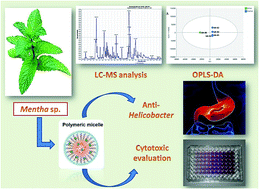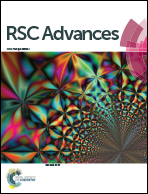The metabolomic analysis of five Mentha species: cytotoxicity, anti-Helicobacter assessment, and the development of polymeric micelles for enhancing the anti-Helicobacter activity
Abstract
Mentha species are medicinally used worldwide and remain attractive for research due to the diversity of their phytoconstituents and large therapeutic indices for various ailments. This study used the metabolomics examination of five Mentha species (M. suaveolens, M. sylvestris, M. piperita, M. longifolia, and M. viridis) to justify their cytotoxicity and their anti-Helicobacter effects. The activities of species were correlated with their phytochemical profiles by orthogonal partial least square discriminant analysis (OPLS-DA). Tentatively characterized phytoconstituents using liquid chromatography high-resolution electrospray ionization mass spectrometry (LC-HR-ESI-MS) included 49 compounds: 14 flavonoids, 10 caffeic acid esters, 7 phenolic acids, and other constituents. M. piperita showed the highest cytotoxicity to HepG2 (human hepatoma), MCF-7 (human breast adenocarcinoma), and CACO2 (human colon adenocarcinoma) cells using 3-(4,5-dimethylthiazol-2-yl)-2,5-diphenyltetrazolium bromide (MTT) assays. OPLS-DA and dereplication studies predicted that the cytotoxic activity was related to benzyl glucopyranoside-sulfate, a lignin glycoside. Furthermore, M. viridis was effective in suppressing the growth of Helicobacter pylori at a concentration of 50 mg mL−1. OPLS-DA predicted that this activity was related to a dihydroxytrimethoxyflavone. M. viridis extract was formulated with Pluronic® F127 to develop polymeric micelles as a nanocarrier that enhanced the anti-Helicobacter activity of the extract and provided minimum inhibitory concentrations and minimum bactericidal concentrations of 6.5 and 50 mg mL−1, respectively. This activity was also correlated to tentatively identified constituents, including rosmarinic acid, catechins, carvone, and piperitone oxide.



 Please wait while we load your content...
Please wait while we load your content...